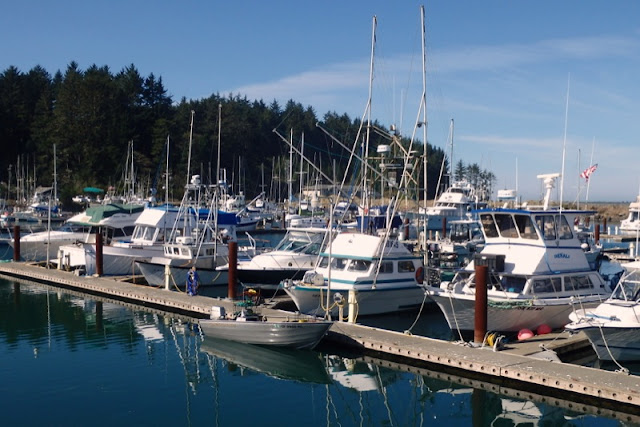One of the things we like looking for when we are cruising are lighthouses. We don’t go out of our way to find them but we do enjoy them when we are close. Some lighthouses are easier to see from land and some can only be seen from the water. The west coast has a lot of interesting lighthouses; unfortunately we missed a few we were close to because of fog, restricted access or time. We covered 3000 miles on our Pacific coast adventure, that’s about the same or even more than some of our entire cruising seasons. It’s amazing how much of the countryside you can cover in one day when you travel by car compared to a slow boat, but when we travel on the boat we absorb so much more…we have more time to soak it all in. This was a fun adventure, but I think I prefer traveling on our boat. That way no matter where we are…we’re home.
We've seen 200 lighthouses while we've cruised the coast of the United States, Canada and the Bahamas. You can see those pictures at this link.
The Yaquina Head Light, also known early in its existence as the Cape Foulweather Lighthouse was built in 1871 and opened in 1873. It’s located near Newport, OR. The tower stands 93 feet tall and is the tallest lighthouse in Oregon. It was built in Paris and shipped to Oregon.
The
Yaquina Bay Light was built in 1871 soon after the founding of the city of
Newport, Oregon. It’s located on the north side of Yaquina Bay. Newport was the
most populated port between Puget Sound and San Francisco at the time. The light was active for only three years due
to the establishment of the Yaquina Head Light in 1873 which is located 3 miles
north of Yaquina Bay.
Cleft
of the Rock Light is a privately owned lighthouse located 1.8 miles south of
Yachats on Cape Perpetua, it marks the spot for vessels sailing the coast
between Coos Bay and Yaquina Bay. It was built in 1976 by former lighthouse
keeper and noted maritime historian Jim Gibbs, Cleft of the Rock Lighthouse
takes its name from the hymn by Fanny J. Crosby, “He Hideth My Soul in the
Cleft of the Rock,” which is based on Exodus 33:22.
Heceta
Head Lighthouse is a working lighthouse built in 1894. It sits 205 feet above
the ocean and the light can be seen from 21 miles out to sea. It's the
brightest light on the Oregon coast and said to be the most photographed lighthouse
in the United States. It’s located 13 miles south of Yachats, OR and 13 miles
north of Florence, OR.
The
Umpqua River Light was built in 1892 and first lit in 1894. It is located at the
mouth of the Umpqua River on Winchester Bay, OR.
Coquille River Light was built in 1895 located near Bandon, OR. It's located in Bullards Beach State Park at the end of the beach access road. Cape Blanco Light was built in 1870 and located on Cape Blanco, near Port Orford, OR. It stands on Oregon’s farthest west point of land and is the oldest lighthouse continually operating in Oregon.
After
modern counterparts replaced the original fog bell and Fresnel lens at Trinidad
Head Lighthouse in 1947, the Coast Guard donated the historic artifacts to the
Trinidad Civic Club for display in a planned memorial park overlooking Trinidad
Bay, CA. In 1949 the club built a concrete Trinidad Memorial Lighthouse which is an
accurate replica of the original Trinidad Head Lighthouse.
Table
Bluff Lighthouse was built in 1892 and is located on Table Bluff just south of
Humboldt Bay close to Eureka, CA
Fisherman's Memorial in Eureka, CA





















































